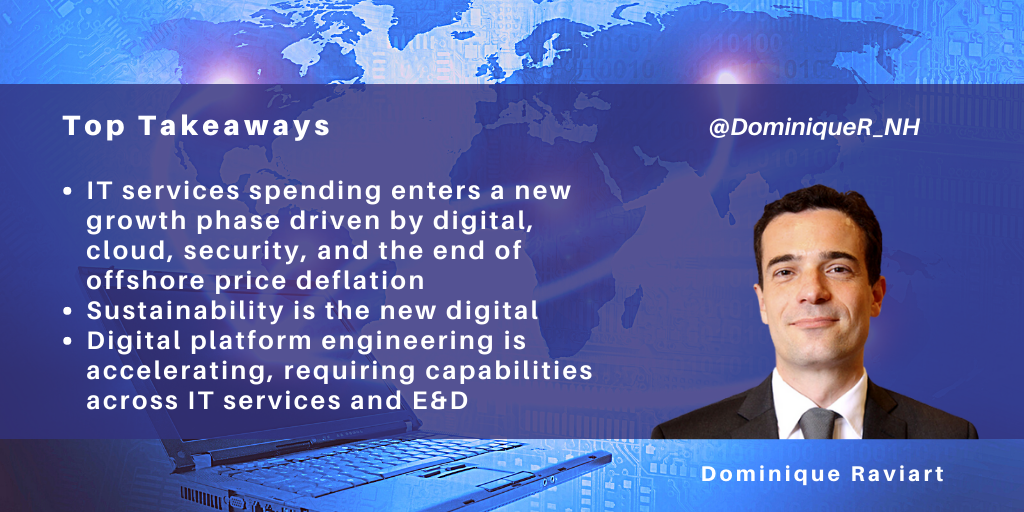posted on Jan 06, 2022 by Dominique Raviart

Here’s how NelsonHall expects the IT services market to shape up in the year ahead.
IT spending will be sustained in 2022
Organizations quickly resumed their IT service spending in 2021: after a decline of over 3.4% in 2020, IT spending rebounded in 2021, reaching 6.9% year-on-year growth (of course, against a soft compare). We are predicting growth of 5.5% in 2022.
IT service spending is cyclical. However, its link to GDP growth has changed. During the period 2015-2019, IT services spending grew by 100 bps slower than real GDP growth. We currently expect IT services will grow 100 bps faster than real GDP growth in the next three years. NelsonHall believes that the industry has entered an acceleration phase for two principal reasons:
- The industry is exiting a 20-year period where offshoring, IT outsourcing, and then migration of cloud infrastructures impacted spending, despite volume increases. The effect of these is now waning
- Digital continues to expand. Organizations will continue to invest in front-office and ERP SaaS applications, data & AI, UX/design thinking, RPA and automation, and IoT. This vast technology ecosystem also drives demand for cloud-based hosting and cybersecurity services.
Sustainability will become a significant part of digital. While current spending is tiny, it is expanding quickly beyond an initial internal focus – to attract personnel and investors – to an external service. Carbon emission assessments are a starting point. We are already seeing some activity in areas such as plastics reduction and product sustainability in the Nordics, going beyond cost savings to environmental neutrality.
M&As: a lot of tuck-ins and…
The IT services industry quickly resumed its M&A activity in 2o21. Accenture continues to be the most active acquirer, with $4.2bn investment in its FY21 spread across 46 transactions, and it has similar ambitions for FY22. Accenture favors tuck-in acquisitions, though some also bring specialist scale.
Deloitte, Cognizant, Infosys, IBM Consulting (the former GBS), and Atos also followed an active tuck-in strategy, albeit at much lower volumes. NTT DATA had a tranquil year, reflecting, we think, its past acquisition integration and coordination work. Capgemini completed a few M&As, primarily targeting the Australian market, but remained focused on the integration of Altran in a volatile ER&D market.
Fujitsu was, as always, quiet on the M&A front, while TCS demonstrated, again, it does not need M&As to produce one of the best organic growths in the industry.
… Significant infrastructure divestments
We will also remember 2021 as a year vendors looked to divest sizeable IT infrastructure services businesses. IBM spun off Kyndryl, creating a $19bn giant. Kyndryl has guided the markets that it expects to resume growth by 2025: the new company will require four years to complete its transformation despite its financial means.
While IBM span off its entire IT infrastructure business, Atos has taken a more selective route, divesting some of its data center estate, related services, and its UCC/Unify product business. In total, Atos will divest €1.8bn in revenues from its IT infrastructure portfolio.
Globally, vendors are reconsidering their IT infrastructure service portfolio. TietoEVRY, the Nordic giant, wants to ‘partner’ in this space; the company has not yet indicated if the partnership will be a straight divestment or take a different form.
Meanwhile, DXC has reaffirmed that its IT infrastructure services business is strategic and has kept digital workplace services internal after the successful disposal of non-core assets and a significant net debt reduction.
Looking ahead, while cloud infrastructure continues to replace on-premise hosting, significant transformational opportunities remain around UCC and ITSM, automation, data & AI, and user experience.
IT services and ER&D overlap around digital technologies & platform engineering
While major IT services vendors reconsidered their IT infrastructure presence, they rushed into ER&D services. Both IT and ER&D services increasingly overlap in agile development, software product development, data & analytics, IoT and digital manufacturing, security, UX/design thinking, and PLM.
After the 2020 acquisition by Capgemini of Altran, we saw a few significant transactions. Accenture acquired a German onshore vendor, Umlaut, bringing 4.2k personnel. Cognizant also purchased a German specialist, ESG Mobility, bringing 1k automotive engineering specialists.
There is more to this overlap. Internet vendors, such as the FANGs and B2C online operations require web applications of high quality that can process millions of transactions. Vendors with a software product development strength such as EPAM and Cognizant Softvision have successfully established themselves in this digital platform engineering space.
We think the future lies in digital platform engineering, which fits the offshore model well, and draws on the strengths of both the IT services (agile development) and ER&D (software product quality) industries. This is an attractive market, and several vendors are ready to invest. Hitachi, for instance, did not hesitate to spend an impressive $9.6bn for GlobalLogic, a Californian vendor with FY21 revenues of $921m. We expect more IT service vendors to expand into digital platform engineering services in 2022.
